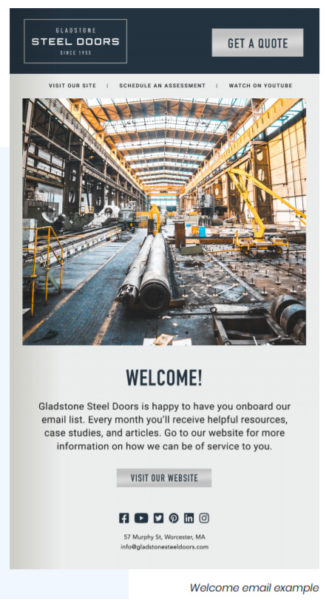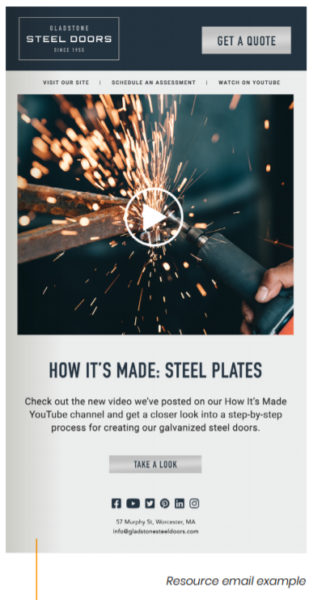
Learn about email market segmentation for manufacturers. Constant Contact’s manufacturing marketing resources can help you be more confident about marketing.
Manufacturing is an important force behind the U.S. economy — accounting for 11.39% of its economic output in 2019. Furthermore, manufactured goods make up at least half of the exports that come from the United States.
As a key part of the modern economy, manufacturing businesses can make use of modern marketing tactics. One essential manufacturing marketing tool to take advantage of is segmentation — which helps you target specific audience members with specific content.
Essentially, market segmentation is dividing your audience into smaller, more approachable groups — for email campaigns, ads, social media, and beyond — based on demographics and common interests.
In this article, we’ll cover:
- The power of email segmentation
- What types of segmentation to use
- How to get started with segmentation
- Next steps
Ready to take charge of your marketing efforts? Understanding market segments can allow you to create service and product offerings for specific demographics — which can help you grow your manufacturing business.
Ready to get new manufacturing deals and repeat business — all in one place?
The power of email segmentation
One of the most powerful ways to use segmentation is in your email marketing, where you divide your email subscribers into specific groups. This is a way to personalize your marketing based on location, purchase history, interests, and feedback.

Segmentation allows you to tailor your marketing to each list of subscribers and their unique interests — versus creating a generic message to all of your subscribers. Specifically curated emails are much less likely to get deleted than messages that are sent to your email list as a whole.
Roughly 306 billion emails are sent every day. Email segmentation with tailored content is one of the best ways to make sure your marketing efforts don’t get lost in the noise. Benefits of market segmentation for manufacturers include:
- Creating stronger marketing strategies — and staying on message
- Delivering targeted digital marketing
- Increasing email engagement
- Attracting the right customers for your business
- Increasing brand loyalty
- Standing out from the competition
- Identifying new niche marketing
- Driving growth
According to Bain & Company, 81% of companies enjoyed growing profits as a result of segmentation.
What types of segmentation to use
Ultimately, the type of segmentation to use depends on the specific type of manufacturing business and the diversity of your customers — which can be determined by your existing knowledge of the industry and marketing research.
There are multiple ways to segment your audience:
Demographics
Demographic segmentation is one of the most basic forms. You can sort your audience using elements such as education, income, age, family size, race, gender, and occupation.
This form of segmentation is one of the most commonly used — and for good reason. Consumers often make choices about the goods and services they buy based on their demographic factors, so it’s an excellent tactic for smaller businesses.
You might use demographic segmentation to target a certain age group. For example, millennials and baby boomers might respond to very different marketing campaigns.
Geography
The effectiveness of geographic segmentation relies on location-driven differences in customers — such as interests, preferences, and needs affected by region. You can gain a deeper understanding of how to segment your audience geographically by considering the climates and qualities of their specific area.
For example, a customer who lives in sunny California faces entirely different climate conditions than a Wisconsinite in the middle of winter. As such, their needs and consumer habits might be in stark opposition to one another — you can use this to market to the right audience at the right time.
Firmographic
Similar to demographic segmentation in nature, firmographic segmentation focuses on organizations rather than individual customers. Factors like the number of employees, company size, revenue, and industry location help you identify the right marketing tactics for a small startup versus a large corporation.
Just as in geographic segmentation, you can use this information to market to the right company at the right time. Seasonal factors can also play a part. For example, a holiday decor company might be more open to doing business at certain times of the year.
Behavior
Behavioral segmentation focuses on decision-making patterns. These behaviors include purchases, lifestyle choices, service usage, and goods consumption. Dividing your markets based on purchase behavior helps you to target the right audience more effectively — it allows you to focus on services and goods they have already demonstrated a preference for. This type of segmentation is more advanced and requires consumer research.
For example, a construction company might purchase specific metal to fit its building needs, while a design firm might buy metal for aesthetic purposes.
Psychographic
Psychographic segmentation accounts for the psychological motivation behind consumer behavior. It relies on factors such as lifestyle, personality traits, interests, values, and opinions. This tactic is more advanced and requires an understanding of lifestyle and its implications.
For example, a wellness company might target consumers who have shown a vested interest in fitness and a healthy lifestyle.
How to get started with segmentation
Now that you understand the different types of segmentation, it’s time to start applying it to your manufacturing email marketing strategies. There are five basic steps to segmentation:
1. Define your audience
First, determine who your market is. Consider:
- Where is there a need for your manufacturing services or manufactured goods?
- What size is your market?
- Where does your business currently fit in your industry?
2. Segment your market
Based on what you already know about your customers, decide which type of segmentation you want to use to organize your audience:
- Demographic
- Geographic
- Firmographic
- Behavioral
- Psychographic
Remember, you can use more than one segmentation tactic to guide your marketing. Explore one or more factors to determine which segmentation style tells you the most about your customers and how to serve them.
3. Understand your audience
Once you choose your segmentation method, use research to understand each segment more deeply. Gather valuable information about your audience with:
- Research surveys
- Focus groups
- Polls
- Click segmentation
Your research can use a combination of quantitative questions — using multiple-choice and selectable boxes — and qualitative questions, or open text responses. You can also take advantage of more automated data, such as click segmentation.

4. Segment your customer lists
Using the data you’ve gathered from your research, segment your market into the appropriate lists — these are the carefully curated lists you will use to launch email campaigns, target ads, and create compelling content.
As you divide your market, determine which segments are most valuable and relevant to your business. Your focus should be on the most viable segments, as they are most likely to help you build your business.
5. Tailor your marketing to meet your segments
Once you have distilled your research into segments, customize your email marketing campaigns to send relevant information to those specific segments.
This will be a major help in organizing your audience to maximize your marketing power. Take full advantage of this tool by creating compelling campaigns that persuade your unique segments.
Next steps
Now that you understand the power of segmentation, the types you can use, and how to implement it, are you ready to get started?
Use Constant Contact’s step-by-step guide to segment your email list and start sending tailored messages today.
To better understand how email marketing fits into your marketing strategies as a whole, download our free online marketing guide for manufacturing. You’re just a few steps away from making the most of your hard-working manufacturing business.




